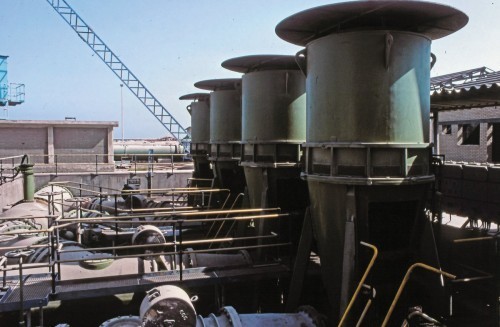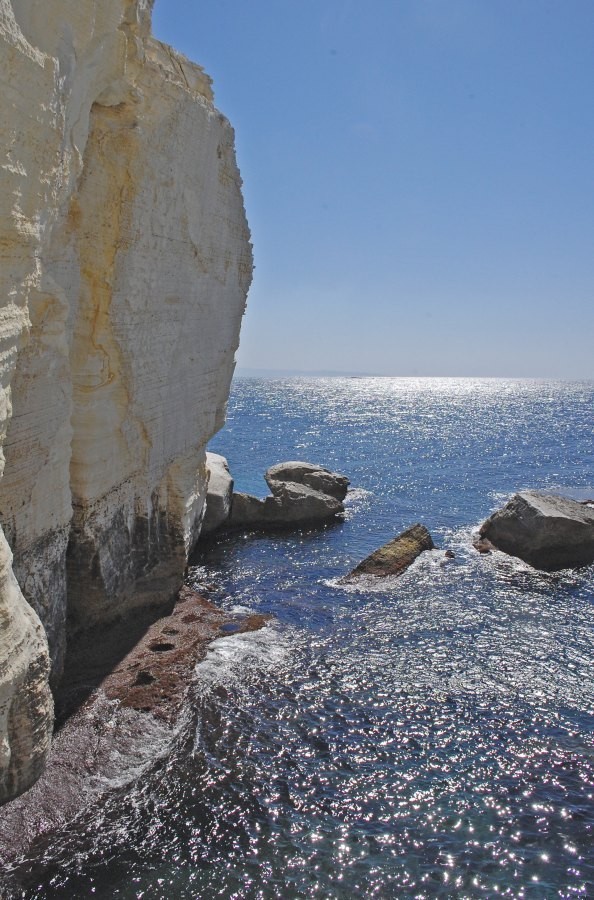Water is a vital and therefore indispensable resource, but in its behavior it is often a strange liquid. Part 2 of the article describes the physico-chemical properties of water, its phenomena and anomalies.
H2O- a strange molecule
After this overview of water as a vital resource, let us now turn to the water molecule and its special physico-chemical properties.
If you convert the Earth's water supply of approx. 1.4 billion km3 into the number of water molecules, you get the gigantic figure of 4.7∙1046. A figure without practical significance, because the physico-chemical properties of water do not result from a number of water molecules existing independently of each other (n∙H2O), but from the interactions between the molecules. Water is therefore to be understood as a system of cross-linked water molecules. As is known from physical chemistry, the reason for this is the angled arrangement of the atoms and the resulting polarization of the OH bond with the negative and positive charge centers in the molecule (water molecule as a dipole). The cross-linking takes place via hydrogen bonds, so-called secondary valence bonds. The spatial arrangement results in a more or less distorted tetrahedral structure, which enables four hydrogen bonds (H-bonds) per molecule with neighboring water molecules. In liquid water, the hydrogen bond behaves dynamically, i.e. the H-bonds constantly change their partners. In contrast, ice has a largely perfect tetrahedral structure.
In comparison with homologues (e.g. H2S), this structural peculiarity of the water molecule gives rise to a large number of practically significant anomalies [4, 7-9, 11, 15]. There are said to be 74 in total. Some of them will be the subject of this article.
Water - phenomena and anomalies
 Kuwait is one of the driest regions on our planet. The freshwater requirements of humans and animals are therefore met by seawater desalination plants, among other things.The density anomaly of water (maximum density at 4° C) with its positive but also negative effects isgenerallyknown. On the positive side, the specifically lighter ice is located on the surface of the water, which means that ice formation in bodies of water proceeds from top to bottom, giving aquatic life a good chance of survival in freezing conditions. On the other hand, icebergs pose a danger to shipping or ice formation due to the expansion of the solid phase causes the destruction of water-bearing plant components. Weathering is also based on the density anomaly (destruction of soaked structures during frost, but support for soil formation). The lowering of the melting point when the pressure increases is also closely related to the density anomaly, an important prerequisite for ice skates to be able to glide on ice surfaces, as well as glaciers on their subsoil.
Kuwait is one of the driest regions on our planet. The freshwater requirements of humans and animals are therefore met by seawater desalination plants, among other things.The density anomaly of water (maximum density at 4° C) with its positive but also negative effects isgenerallyknown. On the positive side, the specifically lighter ice is located on the surface of the water, which means that ice formation in bodies of water proceeds from top to bottom, giving aquatic life a good chance of survival in freezing conditions. On the other hand, icebergs pose a danger to shipping or ice formation due to the expansion of the solid phase causes the destruction of water-bearing plant components. Weathering is also based on the density anomaly (destruction of soaked structures during frost, but support for soil formation). The lowering of the melting point when the pressure increases is also closely related to the density anomaly, an important prerequisite for ice skates to be able to glide on ice surfaces, as well as glaciers on their subsoil.
The "airy" tetrahedral structure of the ice is destroyed when the pressure increases and changes into the dense structure of meltwater. Under very high pressures, e.g. 2000 bar, water only solidifies at -22 °C. At approx. 6.2 kbar, water freezes again at 0 °C. In contrast, at 32 kbar the melting point is 100 °C [11]. The fact that there are water reservoirs trapped deep under layers of ice is also due to the pressure dependence of the melting point. Example: Lake Vostok, with a depth of 500 m and an area of 10,000 km2 the largest water reservoir in the Antarctic, ice cover above the lake approx. 4 km, pressure approx. 350 bar, water temperature -3 °C [4, 10].
However, melting point depression also occurs with increasing salinity. This means, for example, that brackish water (mixed river/sea water; salt content: approx. 0.1 ... 2.5 %) and seawater (salt content: approx. 3.5 %) can only freeze at temperatures of -1 °C ... -3 °C. An extreme case is the Dead Sea with a salt content of 34 % (increases continuously due to high evaporation and insufficient inflow without outflow). Ice formation is inconceivable here under natural conditions.
Polar ice and glaciers represent freshwater reserves (globally: approx. 2.7 % of the total water supply). Fresh water because salts remain in the liquid phase during ice formation. There are even plans to transport icebergs from the Antarctic to freshwater-deficient areas. Melting ice without using the meltwater, on the other hand, means a loss of freshwater, as the meltwater mixes with the seawater. Projections have shown, for example, that the global sea level could rise by around 6 to 7 meters if all the terrestrial ice on Greenland were to melt as a result of global warming. A scenario that will hopefully never become reality on this scale. According to press reports, Greenland even sees the export of meltwater as a business model. Other anomalies are the comparatively high values for enthalpy of melting and evaporation, specific heat capacity, surface tension, viscosity, dielectric constant and sound absorption [11]. Water is almost incompressible and can still be liquid far below the freezing point due to supercooling (purest water down to -20 °C). However, supercooled water is unstable, so that impurities and temperature increases lead to ice formation.
Due to its high specific heat capacity, water is suitable for storing and transferring heat in technical systems. Seas and lakes have a balancing effect on the climate through evaporation and heat release. The low thermal conductivity makes it difficult to heat the cold deep water in bodies of water and reservoirs, so that its better quality can be used for the supply of drinking water.
The surface tension of the water enables capillary effects, which are essential for the bottom-up transport of water and nutrients in plants and trees. The maintenance of soil moisture, corrosion in porous materials and the blood supply to deep tissue layers in biological systems are also based on capillary effects.
The high dielectric constant underlines the fact that water is a polar and, in conjunction with its other material properties, a universal solvent, reaction, swelling and transport medium. The complex fluid blood and the blood circulation are a vivid example of this.
Although the molecular structure of water is considered to be quite well studied (see numerous models and data collections [7-9, 11], Wikipedia), there are obviously still deficits in our understanding of the relationship between water structure and the behavior of this "strange fluid". This is certainly one of the reasons why water is often attributed with miraculous powers that often slip into the esoteric.
It is therefore instructive to look at the increase in the order of the water structure when it cools down to the crystalline ice structure. It is an example of conservative self-organization, a process in which a temperature equilibrium with the environment is sought in the water/ice system [12, 13].
The Boltzmann principle applies:
S = k ∙ lnW<2>
S is the state variable entropy, a measure of the disorder and valence of the energy in the system. k is the Boltzmann constant.
 Lakes and especially seas (here the English Channel near Dièppe, Normandy) act as climate buffers. They absorb the heat from the overheated atmosphere and release it again as haze. Nevertheless, the oceans are also getting warmer and warmerEquation2 thus represents a link between entropy and the probability W of how many different arrangements of H2Omolecules are possible via H bridges at a certain temperature without changing entropy and total energy. An increase in order means a decrease in entropy (∆S<0) in the water system due to entropy export and heat dissipation to the environment when W is reduced. The latter results from the reduction in dynamics during the formation of H-bridges when the water system cools down. At the solidification point there is a minimum energy for the H2Omolecules. Theoretically, at absolute zero, W = 1 and S = 0. When water interacts with biomolecules, the arrangement of H bridges determines their shape and properties and thus the dynamics of essential life processes [14, 15]. One example of this is protein folding. The ice structure of meltwater is mentioned in particular when it comes to the optimal interaction of biomolecules and water in biosystems. Biomolecules also have an effect on the water structure, as non-electrolytes, for example, can stabilize H-bridges [26]. In contrast, various electrolytes (chaotropic substances) reduce the degree of order of the water structure (entropy increase, ∆S>0) by destroying H bridges [11]. This reduces the driving force of vital protein folding, for example.
Lakes and especially seas (here the English Channel near Dièppe, Normandy) act as climate buffers. They absorb the heat from the overheated atmosphere and release it again as haze. Nevertheless, the oceans are also getting warmer and warmerEquation2 thus represents a link between entropy and the probability W of how many different arrangements of H2Omolecules are possible via H bridges at a certain temperature without changing entropy and total energy. An increase in order means a decrease in entropy (∆S<0) in the water system due to entropy export and heat dissipation to the environment when W is reduced. The latter results from the reduction in dynamics during the formation of H-bridges when the water system cools down. At the solidification point there is a minimum energy for the H2Omolecules. Theoretically, at absolute zero, W = 1 and S = 0. When water interacts with biomolecules, the arrangement of H bridges determines their shape and properties and thus the dynamics of essential life processes [14, 15]. One example of this is protein folding. The ice structure of meltwater is mentioned in particular when it comes to the optimal interaction of biomolecules and water in biosystems. Biomolecules also have an effect on the water structure, as non-electrolytes, for example, can stabilize H-bridges [26]. In contrast, various electrolytes (chaotropic substances) reduce the degree of order of the water structure (entropy increase, ∆S>0) by destroying H bridges [11]. This reduces the driving force of vital protein folding, for example.
Water is even described as a mixture of different liquids, comparable to an emulsion (theory of two types of water), due to different arrangements of H-bridges and thus different molecular distances in connection with density differences [15]. H-bridges in conjunction with other attractive forces (ion-ion, ion-dipole, dipole-dipole, London dispersion forces) are obviously the key to further elucidation of still existing secrets in the water system.
With regard to the movement of water (flow, wave formation), two further forms of structure formation through self-organization will be briefly discussed. The first is order through dissipative self-organization, a process which, in contrast to conservative self-organization, only takes place in open systems (exchange of matter and energy with the environment) and at a supercritical distance from thermal equilibrium [12, 13, 17, 18]. Further criteria, which are only mentioned here, are: Energy transformation, non-linearity, symmetry breaking, feedback and operational closure. Entropy export is analogous to conservative self-organization. The Bernard effect is almost a textbook example.
By heating a thin layer of water from below, a temperature gradient is formed. After an initially chaotic interplay between buoyancy forces, heat conduction and convection effects, dissipative self-organization suddenly begins at a certain temperature gradient (supercritical distance from equilibrium). Small hexagonal cells (Bernard cells) are formed, which circulate vertically and thus support the energy and entropy transport in the water system. This is dynamic order, which only breaks down again when a critical temperature gradient is exceeded and turns into turbulent chaos [17].
Complex biological systems are another example. Through dissipative self-organization, the high state of order is largely maintained throughout life despite the tendency towards chaos. The driving force is energy transformation (chemical energy of nutrients via the formation of ATP, adenosine triphosphate, into free energy) for cellular work (cooperative processes such as cell renewal, muscle contraction, molecular synthesis, biosynthesis, active mass transport, maintenance of electrical potential differences). Water plays a decisive role as a solvent, reaction and transport medium, as biological systems consist of 60 ... 70 % water. More on this in [17, 19].
This leaves dispersive self-organization, briefly explained using special waves, solitons, also known as solitary waves [12, 20]. Waves usually disintegrate as a result of a large number of small disturbances, e.g. internal friction, and strive towards chaotic equilibrium (dispersion) in accordance with the second law of thermodynamics. The observation in 1834 that a dimensionally stable wave traveled long distances in a channel apparently without any loss of energy or speed was therefore sensational [20]. Today we know that, under certain conditions, non-linear interactions and feedback can prevent dispersion and trigger structure formation through self-organization (principle of tsunamis) Solitons are an interesting example of how water can perform work as a carrier of mechanical energy in a variety of ways.
- to be continued -
Literature
[1] Fischwasser, K.: Galvanotechnik, 104th volume, 2013, issues 1, 3, 6, 7, 8
[2] Hydrology, textbooks for university correspondence courses, parts 1 to 3, TU Dresden, Water Engineering Section (GDR)
[3] Maniak, U.: Hydrologie und Wasserwirtschaft, Eine Einführung für Ingenieure, 2nd edition, Springer Verlag, Berlin Heidelberg New York, 1992
[4] Hopp, V.: Water crisis? Water, Nature, Man, Technology and Economy, Wiley-VCH Verlag GmbH & Co. KGaA, Weinheim, 2004
[5] Technical articles in the IWW Journal, issues 49 (December 2018), 50 (July 2019) and 52 (June 2020)
[6] Abhandlungen der Sächsischen Akademie der Wissenschaften, Mathematisch-naturwissenschaftliche Klasse, Volume 66, Issue 5 Biodiversity, bioenergy, water quality, 2020
[7] Kümmel, R.: Water - Sphinx among the liquids, Acta. hydrochim. hydrobiol., 18 (1985) 5, 541-548
[8] Anders, S.: Rund um das Wasser - ein physikalischer Streifzug, Kleine Naturwissenschaftliche Bibliothek, Volume 54, 1st edition BSB B.G., Teubner Verlagsgesellschaft, Leipzig, 1983
[9] Gordalla, B.C.; Müller, M.B.; Frimmel, F.H.: 1.2 Die physikalisch-chemischen Eigenschaften des Wassers und ihre Bedeutung für das Leben, 1. Lebenselexier Wasser - betrachtet aus der Sicht von Natur- und Gesellschaftswissenschaften. From: Warning signal climate: Enough water for all?, 3rd edition (2011), 31-39
[10] Milestones of science - A journey through time, Spektrum Akademischer Verlag, 1st edition, 2005, 520
[11] RÖMPP Chemielexikon, vol.6, 9th edition, Georg Thieme Verlag, Stuttgart, New York, 1995
[12] Ebeling, W.: Physical principles of the self-organization of matter Urania 6/83, 32-37
[13] Ebeling, W.; Feistel, R.: Chaos and Cosmos - Principles of Evolution, Spektrum Akademischer Verlag, Heidelberg, Berlin, Oxford, 1994
[14] Gerstein, M.; Levitt, M.: The simulation of biomolecules in water, Spektrum der Wissenschaft, Febr. 1999, 47-51
[15] Saager, N.; Weber, A.: Water as a miracle substance, P.M. 12/2019, 20-29
[16] Vieweger, D.: Dispute over the Holy Land. 3rd revised and updated edition, Gütersloher Verlagshaus, 2011
[17] Nikoles, G.; Prigogine, J.: Die Erforschung des Komplexen, R. Piper GmbH & Co. KG, Munich 1987
[18] Nachtigall, W.: Bionik - Grundlagen und Beispiele für Ingenieure und Naturwissenschaftler, Springer-Verlag, 2nd edition, 2002
[19] Fischwasser, K.: Fitness - bioenergetisch betrachtet umak- Internet-Gesprächsrunde 2020, conference manuscript, essay (in preparation)
[20] Briggs, J.; Peat, D.F.: Die Entdeckung des Chaos, Carl Hanser Verlag, Munich, Vienna, 1990


